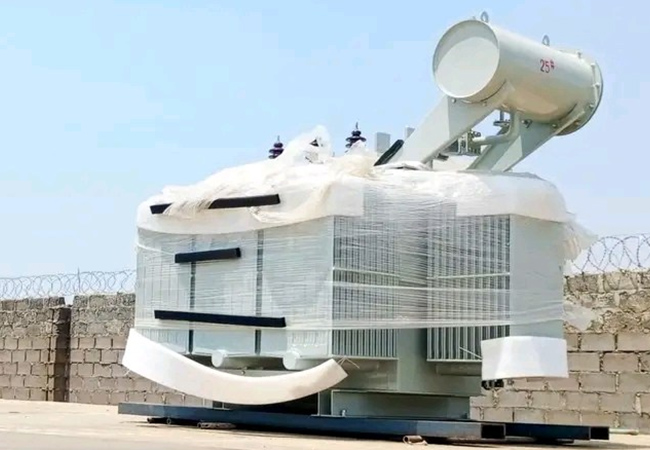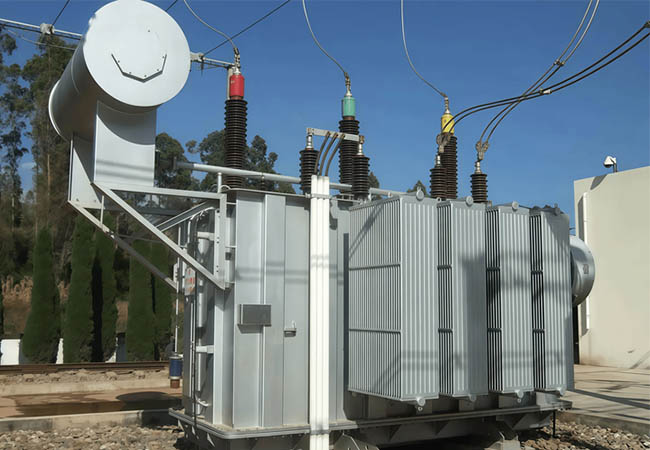16 Transformer Facts That Electrical Professionals Must Know!
10-10 2024 | By:
Transformers are indispensable in the operation of power distribution. It is very necessary to be familiar with and master the basic knowledge of transformers. The basic knowledge of transformers is a necessary skill for every power person!
1. What is a transformer?
In an AC circuit, a device that increases or decreases voltage is called a transformer. The transformer can convert any voltage value into the voltage value we need with the same frequency to meet the requirements of power transmission, distribution and use.
For example, the electricity generated by a power plant has a low voltage level. The voltage must be increased to be transmitted to a distant power consumption area. The power consumption area must be reduced to a suitable voltage level to supply power equipment and daily power equipment.
2. How does the transformer transform voltage?
The transformer is made based on electromagnetic induction. It consists of an iron core stacked with silicon steel sheets (or silicon steel sheets) and two sets of coils wound on the iron core. The iron core and the coil are insulated from each other and there is no electrical connection.
It has been theoretically confirmed that the voltage ratio between the primary coil and the secondary coil of the transformer is related to the ratio of the number of turns between the primary coil and the secondary coil, which can be expressed by the following formula: primary coil voltage/secondary coil voltage = primary coil turns/secondary coil turns. The more turns, the higher the voltage. Therefore, it can be seen that if the secondary coil is less than the primary coil, it is a step-down transformer. On the contrary, it is a step-up transformer.
3. What are the types of transformer design?
According to the number of phases, there are single-phase and three-phase transformers
According to the purpose, there are power transformers, special power transformers, voltage regulating transformers, measuring transformers (voltage transformers, current transformers), small power transformers (for low-power equipment), and safety transformers.
According to the cooling method, there are oil-immersed and air-cooled types.
4. What are the components of the transformer?
The transformer components are mainly composed of iron cores and coils. In addition, there are oil tanks, oil pillows, insulating bushings, and tapping heads.
5. What is the use of transformer oil?
The functions of transformer oil are:
(1) Insulation
(2) Heat dissipation
6. What is an autotransformer?
An autotransformer has only one set of coils. The secondary coil is tapped from the primary coil. Its power transmission, in addition to electromagnetic induction transmission, also has electrical transmission. This type of transformer has fewer silicon steel sheets and copper wires than ordinary transformers and is often used to adjust voltage.
7. How does a voltage regulator adjust voltage?
The structure of a voltage regulator is the same as that of an autotransformer, except that the iron core is made into a ring coil and wound on the ring iron core.
The secondary coil tap uses a sliding brush contact to make the contact slide along the coil surface in a ring to achieve a smooth voltage regulation effect.
8. What is the current relationship between the primary and secondary coils of a transformer?
When the transformer is running with a load, the change in the secondary coil current will cause a corresponding change in the primary coil current. According to the principle of magnetic potential balance, the current of the primary and secondary coils is inversely proportional to the number of coil turns. The side with more turns has a smaller current, and the side with fewer turns has a larger current.
It can be expressed by the following formula: primary coil current/secondary coil current = secondary coil turns/primary coil turns.
9. What is the voltage change rate of the transformer?
The voltage change rate of the voltage regulator is one of the main performance indicators of the transformer. When the transformer supplies power to the load, the voltage at the load end of the transformer will inevitably drop. Compare the dropped voltage value with the rated voltage value, and take the percentage, which is the voltage change rate.
10. How to ensure that the transformer has a rated voltage output?
Too high or too low voltage will affect the normal operation and service life of the transformer, so voltage regulation is necessary.
The method of voltage regulation is to lead out several taps in the primary coil and connect them to the tapping head. The tapping head changes the number of turns of the coil by rotating the contacts. As long as the position of the tap switch is turned, the required rated voltage value can be obtained. It should be noted that voltage regulation should usually be performed after the load connected to the transformer is cut off.
11. What are the commonly used small transformers like? In what occasions are they used?
Small transformers refer to single-phase transformers with a capacity of less than 1 kVA. They are mostly used as power transformers for electrical equipment control, power transformers for electronic equipment, and power transformers for safety lighting.
12. What are the losses of transformers during operation? How to reduce losses?
The losses of transformers during operation include two parts:
(1) It is caused by the iron core. When the coil is energized, the magnetic lines of force are alternating, causing eddy current and hysteresis losses in the iron core. This loss is collectively called iron loss.
(2) It is caused by the resistance of the coil itself. When current passes through the primary and secondary coils of the transformer, power loss will be generated. This loss is called copper loss.
The sum of iron loss and copper loss is the transformer loss. These losses are related to the transformer capacity, voltage, and equipment utilization. Therefore, when selecting a transformer, the equipment capacity should be consistent with the actual usage as much as possible to improve the equipment utilization. Be careful not to run the transformer under light load.
13. What is the nameplate of a transformer? What are the main technical data on the nameplate?
The nameplate of the transformer indicates the performance, technical specifications and application scenarios of the transformer to meet the user’s selection. The main technical data that should be paid attention to are:
(1) The kilovolt-ampere of the rated capacity. That is, the output capacity of the transformer under rated conditions. For example, the rated capacity of a single-phase transformer = U line × I line; the capacity of a three-phase transformer = U line × I line.
(2) Rated voltage volts. Indicate the terminal voltage of the primary coil and the terminal voltage of the secondary coil (when not connected to the load) respectively. Note that the terminal voltage of a three-phase transformer refers to the line voltage U line value.
(3) Rated current ampere. Refers to the line current I line value that the primary coil and the secondary coil are allowed to pass through for a long time under the conditions of rated capacity and allowable temperature rise.
(4) Voltage ratio. Refers to the ratio of the rated voltage of the primary coil to the rated voltage of the secondary coil.
(5) Wiring method. A single-phase transformer has only one set of high and low voltage coils and is only used for single phase, while a three-phase transformer has a Y/△ type. In addition to the above technical data, there are also the rated frequency, number of phases, temperature rise, impedance percentage of the transformer, etc.
14. How to choose a transformer? How to determine the reasonable capacity of the transformer?
First, we need to investigate the power supply voltage of the power consumption place, the actual power load of the user and the conditions of the place, and then refer to the technical data indicated on the transformer nameplate to select one by one. Generally, the transformer capacity, voltage, current and environmental conditions should be considered comprehensively. The capacity selection should be based on the capacity, nature and usage time of the user’s power equipment to determine the required load, so as to select the transformer capacity.
In normal operation, the power load borne by the transformer should be about 75-90% of the rated capacity of the transformer. If the actual load borne by the transformer is less than 50% during operation, a small-capacity transformer should be replaced. If it is greater than the rated capacity of the transformer, a large transformer should be replaced immediately.
At the same time, when selecting a transformer, the primary coil voltage value of the transformer is determined according to the line power supply, and the secondary coil voltage value is selected according to the power equipment. It is best to choose a low-voltage three-phase four-wire power supply. This can provide power and lighting power at the same time.
When choosing the current, it is important to ensure that the load meets the requirements of the motor when the motor starts (because the motor starting current is 4 to 7 times greater than when the motor is running downward).
15. Why can’t the transformer be overloaded?
Overload operation means that the transformer exceeds the current value specified on the nameplate during operation.
Under special circumstances, the transformer cannot be overloaded for a short period of time, and cannot exceed 30% of the rated load (in winter), and cannot exceed 15% in summer.
For the latter, the requirements for accident overload and the allowed overtime are shown in the table below.
Picture
16. What tests should be performed on the transformer during operation?
In order to ensure the normal operation of the transformer, the following tests should be performed frequently:
(1) Temperature test. Whether the transformer is operating normally, the temperature is very important. The regulations stipulate that the upper oil temperature shall not exceed 85C (i.e., the temperature rise is 55C). Generally, transformers are equipped with special temperature measurement devices.
(2) Load measurement. In order to improve the utilization rate of the transformer and reduce the loss of electric energy, the power supply capacity that the transformer can actually bear must be measured during the operation of the transformer. The measurement is usually carried out during the peak period of electricity consumption in each season, and is measured directly with a clamp ammeter. The current value should be 70-80% of the rated current of the transformer. If it exceeds this value, it indicates overload and should be adjusted immediately.
(3) Voltage measurement. The regulations require that the voltage variation range should be within ±5% of the rated voltage. If it exceeds this range, the tap should be used to adjust the voltage to the specified range. Generally, a voltmeter is used to measure the secondary coil terminal voltage and the terminal voltage of the end user respectively.
You may also find these interesting:


